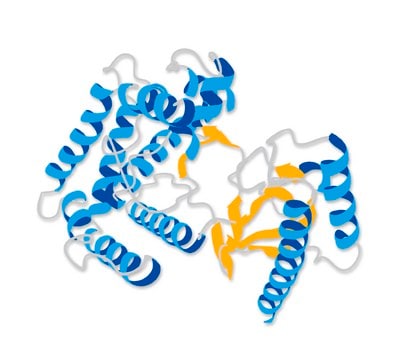Yes, a suitable chromogenic substrate for the enzyme associated with product number P6556 is the S7388, N-Succinyl-Ala-Ala-Pro-Phe p-nitroanilide.
P6556
Proteinasa K from Tritirachium album
lyophilized powder, ≥30 units/mg protein
Sinónimos:
Endopeptidasa K
Seleccione un Tamaño
US$ 67,10
Seleccione un Tamaño
About This Item
US$ 67,10
Productos recomendados
Formulario
lyophilized powder
Nivel de calidad
actividad específica
≥30 units/mg protein
mol peso
28.93 kDa
técnicas
DNA extraction: suitable
solubilidad
H2O: soluble 1 mg/mL, clear, colorless
actividad extraña
Dnase ≤30 Kunitz units/mg solid
RNase ≤0.003 Kunitz units/mg solid
Condiciones de envío
wet ice
temp. de almacenamiento
−20°C
¿Está buscando productos similares? Visita Guía de comparación de productos
Aplicación
Elimina las endotoxinas que se unen a las proteínas catiónicas como la lisozima y la ribonucleasa A.
Se ha comunicado que es útil para el aislamiento de mitocondrias hepáticas, de levadura y de frijol mung
Determinación de la localización de las enzimas en las membranas
Tratamiento de cortes de tejido incluidos en parafina para exponer los sitios de unión de antígenos para el marcado con anticuerpos.
Digestión de proteínas de muestras de tejido cerebral para investigación de los priones en las encefalopatías espongiformes transmisibles (EET).
It is used for the removal of endotoxins bound to cationic proteins such as lysozyme and ribonuclease A.
It is useful for the isolation of hepatic, yeast, and mung bean mitochondria
and is used to determine enzyme localization on membranes
It is used for the treatment of paraffin embedded tissue sections to expose antigen binding sites for antibody labeling and
for digestion of proteins from brain tissue samples for prions in Transmissible Spongiform Encephalopathies (TSE) research. Product P6556 is provided as a lyophilized powder. Product P6556 has been used to break down human lens protein[1].
Acciones bioquímicas o fisiológicas
Definición de unidad
también adquirido normalmente con este producto
Palabra de señalización
Danger
Frases de peligro
Consejos de prudencia
Clasificaciones de peligro
Eye Irrit. 2 - Resp. Sens. 1 - Skin Irrit. 2 - STOT SE 3
Órganos de actuación
Respiratory system
Código de clase de almacenamiento
11 - Combustible Solids
Clase de riesgo para el agua (WGK)
WGK 1
Punto de inflamabilidad (°F)
Not applicable
Punto de inflamabilidad (°C)
Not applicable
Equipo de protección personal
dust mask type N95 (US), Eyeshields, Faceshields, Gloves
Elija entre una de las versiones más recientes:
Certificados de análisis (COA)
¿No ve la versión correcta?
Si necesita una versión concreta, puede buscar un certificado específico por el número de lote.
¿Ya tiene este producto?
Encuentre la documentación para los productos que ha comprado recientemente en la Biblioteca de documentos.
Los clientes también vieron
Artículos
Proteinase K aids in molecular biology applications by digesting structural proteins, removing nucleases, and isolating intact genomic DNA.
Pro K aids in disrupting cell membranes for DNA release, crucial for downstream molecular biology techniques.
Balancing Proteinase K cost with quality and technical support ensures optimal enzyme selection for diverse applications.
Guidelines on use of proteinase K, an enzyme commonly used to degrade proteins, and protect DNA and RNA from degradation in samples.
Protocolos
Proteinase K activity measured via spectrophotometry using hemoglobin substrate, crucial for enzyme characterization.
-
Is there a chromogenic substrate available for product number P6556?
1 answer-
Helpful?
-
-
How can I activate the proteinase K? I need it for a protease assay
1 answer-
Product P6556, Proteinase K, is activated by 0.5 % SDS or 6 M urea.
Helpful?
-
-
Is your "Proteinase K from Tritirachium album" actually isolated from Tritirachium album cultures, or the gene cloned, over-expressed in some bacterium and the Proteinase K isolated from the bacterial cell lysate?
1 answer-
This product is isolated from Tritirachium album culture.
Please see the sample Certificate of Origin below:
https://www.sigmaaldrich.com/certificates/sapfs/PROD/sap/certificate_pdfs/COO/Q12/P6556-1G0000137404.pdfHelpful?
-
Active Filters
Nuestro equipo de científicos tiene experiencia en todas las áreas de investigación: Ciencias de la vida, Ciencia de los materiales, Síntesis química, Cromatografía, Analítica y muchas otras.
Póngase en contacto con el Servicio técnico








